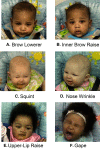Vegetable and Fruit Acceptance during Infancy: Impact of Ontogeny, Genetics, and Early Experiences
- PMID: 26773029
- PMCID: PMC4717875
- DOI: 10.3945/an.115.008649
Vegetable and Fruit Acceptance during Infancy: Impact of Ontogeny, Genetics, and Early Experiences
Abstract
Many of the chronic illnesses that plague modern society derive in large part from poor food choices. Thus, it is not surprising that the Dietary Guidelines for Americans, aimed at the population ≥2 y of age, recommends limiting consumption of salt, fat, and simple sugars, all of which have sensory properties that we humans find particularly palatable, and increasing the variety and contribution of fruits and vegetables in the diet, to promote health and prevent disease. Similar recommendations may soon be targeted at even younger Americans: the B-24 Project, led by the US Department of Health and Human Services and the USDA, is currently evaluating evidence to include infants and children from birth to 2 y of age in the dietary guidelines. This article reviews the underinvestigated behavioral phenomena surrounding how to introduce vegetables and fruits into infants' diets, for which there is much medical lore but, to our knowledge, little evidence-based research. Because the chemical senses are the major determinants of whether young children will accept a food (e.g., they eat only what they like), these senses take on even greater importance in understanding the bases for food choices in children. We focus on early life, in contrast with many other studies that attempt to modify food habits in older children and thus may miss sensitive periods that modulate long-term acceptance. Our review also takes into consideration ontogeny and sources of individual differences in taste perception, in particular, the role of genetic variation in bitter taste perception.
Keywords: breastfeeding; diet; eating behavior; fruits; infant feeding; infants; repeated exposure; taste; variety; vegetables.
© 2016 American Society for Nutrition.
Conflict of interest statement
Author disclosures: JA Mennella, AR Reiter, and LM Daniels, no conflicts of interest.
Figures

References
-
- USDA and US Department of Health and Human Services. Dietary guidelines for Americans, 2010 [Internet]. 7th ed. Washington (DC): US Government Printing Office; 2010 [cited 2014 Oct 8]. Available from: http://www.health.gov/dietaryguidelines/2010.asp.
-
- US Department of Health and Human Services. Healthy people, 2020 topics and objectives: nutrition and weight status. Washington (DC): US Department of Health and Human Services; 2014. [cited 2014 Nov 18]. Available from: http://www.healthypeople.gov/2020/topics-objectives/topic/nutrition-and-....
-
- Knai C, Pomerleau J, Lock K, McKee M. Getting children to eat more fruit and vegetables: a systematic review. Prev Med 2006;42:85–95. - PubMed
Publication types
MeSH terms
Grants and funding
LinkOut - more resources
Full Text Sources
Other Literature Sources
Medical

